7 AI Healthcare Companies You Should Know
Discover the top 7 ai healthcare companies strategies and tips. Complete guide with actionable insights.
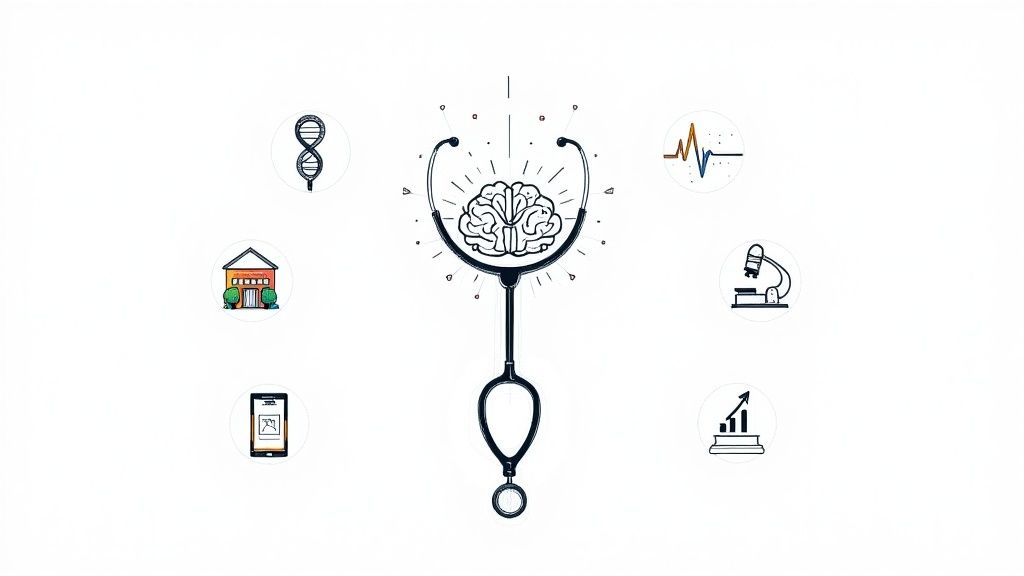
The healthcare industry is undergoing a significant transformation, driven by the integration of artificial intelligence. For business leaders, operations leads, and AI strategists, navigating the complex ecosystem of ai healthcare companies to find the right partner is a critical challenge. This roundup is designed to cut through the noise, providing a direct, comprehensive overview of the key platforms where innovative AI solutions are vetted, listed, and deployed. We'll move beyond generic lists to offer a detailed look at the marketplaces and directories that connect healthcare providers with cutting-edge technology.
This article provides actionable insights into seven leading platforms, detailing their core offerings, unique strengths, and the specific problems they solve. You will learn not just who the key players are, but how to engage with them. For each entry, we provide direct links and practical examples to guide your evaluation process, helping you identify solutions for diagnostic imaging, patient data management, operational efficiency, and more. This curated guide is your starting point for identifying potential partners and technologies that align with your strategic objectives, whether you're developing an initial AI roadmap or scaling existing capabilities.
Our goal is to equip you with the information needed to make informed decisions, streamline your vendor discovery process, and accelerate technology adoption. By understanding these specialized marketplaces, you can more effectively source the right AI tools for business and build a robust foundation for your organization’s AI-powered future. Let’s explore the platforms that are shaping the future of healthcare.
1. AWS Marketplace – Healthcare & Life Sciences
For healthcare organizations already integrated into the Amazon Web Services ecosystem, the AWS Marketplace for Healthcare & Life Sciences serves less as a single product company and more as a powerful launchpad for innovation. It's a curated digital catalog with thousands of third-party software, data, and service listings specifically designed for the healthcare sector. Instead of navigating lengthy traditional procurement cycles, organizations can discover, purchase, and deploy pre-vetted AI solutions directly into their existing AWS environment, dramatically accelerating technology adoption.
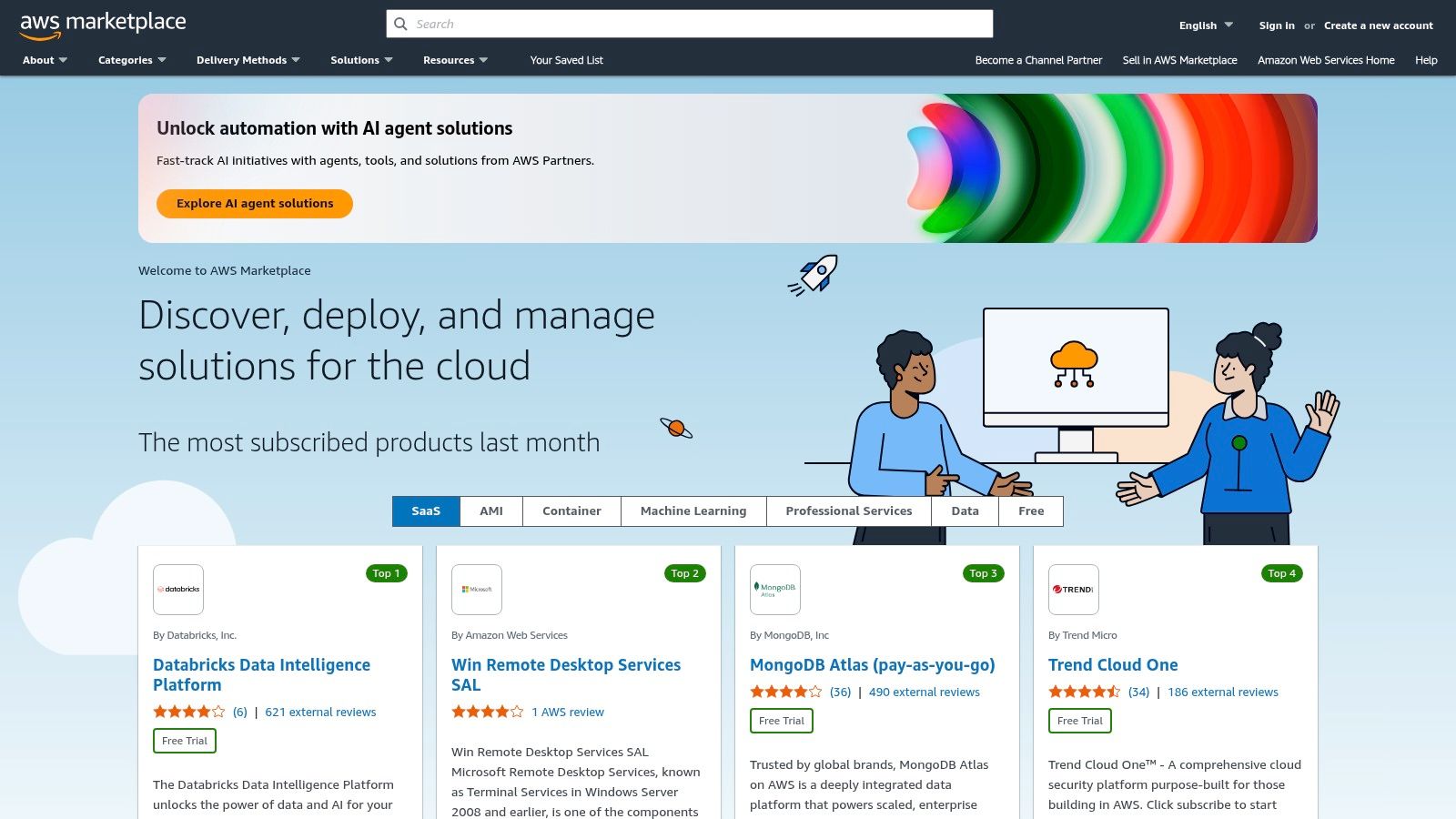
This platform stands out by centralizing a vast array of specialized AI tools for business, making it a key destination for any AI healthcare company looking to build or augment its capabilities. The marketplace simplifies the entire sourcing process, from discovery to deployment and billing, all consolidated within the familiar AWS Management Console. For companies leveraging AWS for their AI healthcare solutions, further insights into development with Amazon Web Services can provide a deeper understanding of the underlying infrastructure.
Core Offerings and Use Cases
The marketplace is segmented to address critical healthcare needs, allowing users to find solutions with precision.
Clinical and Medical Imaging: Find and deploy FDA-cleared AI algorithms for analyzing medical images from vendors like Arterys or Quibim. These tools can assist radiologists in identifying anomalies in X-rays, CT scans, and MRIs, improving diagnostic accuracy and speed.
Clinical Natural Language Processing (NLP): Source powerful NLP models from companies like John Snow Labs to extract structured data from unstructured clinical notes, patient records, and research papers. This is vital for cohort selection in clinical trials and population health analysis.
Revenue Cycle Management (RCM) & Operations: Deploy automation tools that streamline billing, coding, and claims processing. These solutions can reduce administrative overhead and minimize claim denials by ensuring accuracy.
Key Insight: AWS Marketplace allows organizations to use their existing AWS Enterprise Discount Program (EDP) commitments to purchase third-party software. This turns a sunk infrastructure cost into a flexible budget for innovative AI tools, maximizing resource allocation.
Implementation and Pricing
Deployment is a key differentiator. Once a solution is selected, it can be launched directly into your AWS account with just a few clicks, integrating with existing AWS Identity and Access Management (IAM) for secure governance. However, this ease of use requires an established AWS environment and technical familiarity.
Pricing models vary by vendor, offering significant flexibility:
Usage-Based: Pay-as-you-go, ideal for testing or variable workloads.
Contracts: Annual or multi-year subscriptions for predictable budgeting.
Private Offers: Negotiate custom pricing and terms directly with vendors.
Prospective buyers should note that costs often have two components: the software fee from the vendor and the underlying AWS infrastructure costs for running the service. Understanding your AI Product Development Workflow is crucial for managing these integrated costs effectively.
Website: https://aws.amazon.com/marketplace/
2. Microsoft Azure Marketplace (Microsoft commercial Marketplace)
For healthcare systems deeply invested in the Microsoft ecosystem, the Azure Marketplace is an essential hub for accelerating digital transformation. It functions as a comprehensive storefront where organizations can discover, try, and procure a vast range of certified, third-party applications and services built on or for Microsoft Azure. This marketplace streamlines the often cumbersome procurement process, enabling providers and payers to deploy vetted AI healthcare solutions with consolidated billing and governance, making it a critical platform for leading ai healthcare companies.
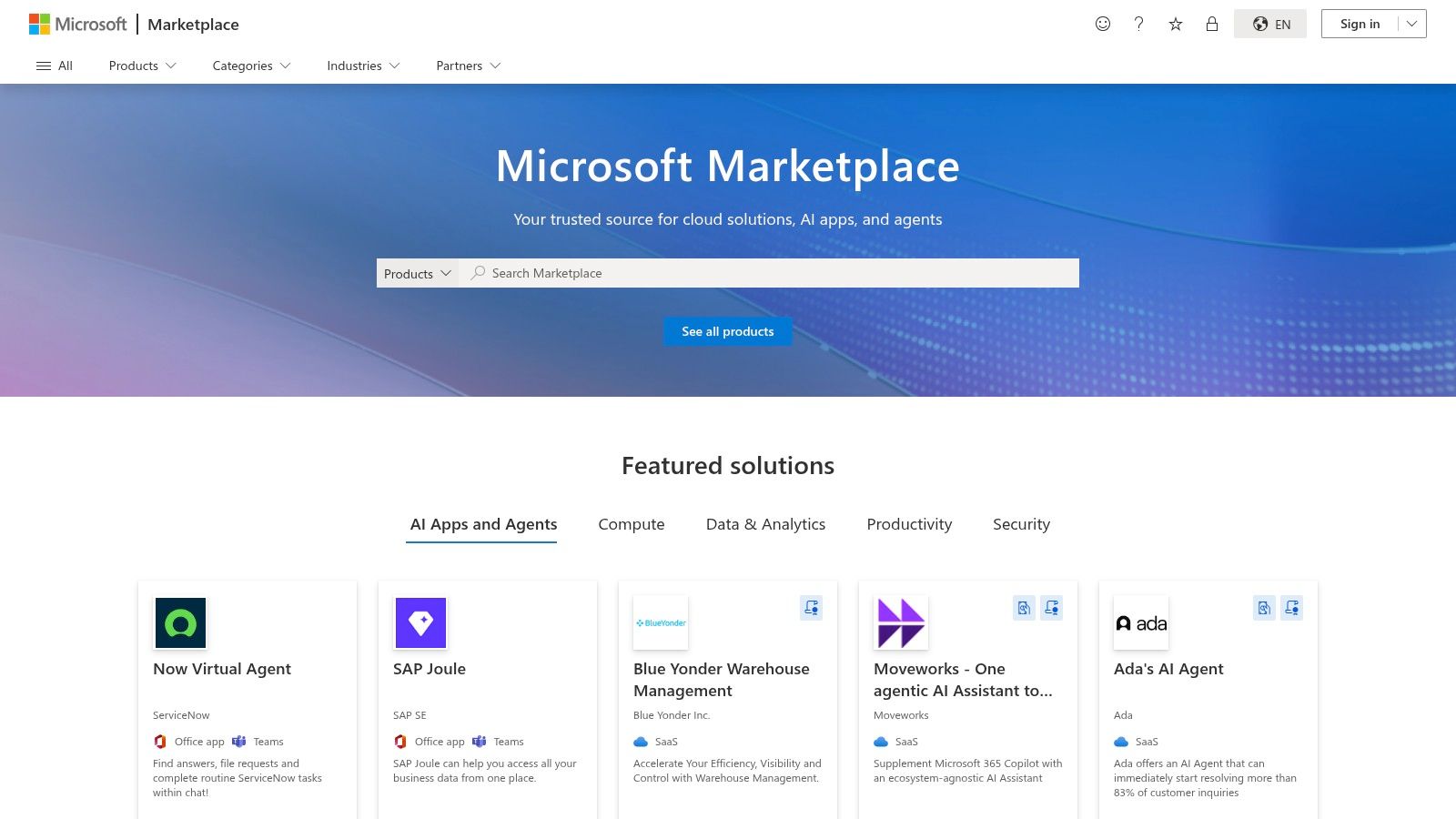
The platform’s strength lies in its tight integration with the broader Microsoft Cloud for Healthcare, including services like Azure Health Data Services and Azure OpenAI. This allows organizations to procure AI solutions that seamlessly connect with their existing data infrastructure and workflows. The marketplace presents a mix of one-click deployable software and professional service offerings, providing a flexible path for organizations to either build their own capabilities or partner with experts for implementation. This dual approach helps organizations align their procurement with their overall AI strategy consulting goals.
Core Offerings and Use Cases
The Azure Marketplace provides a rich catalog of solutions specifically categorized for the healthcare industry, addressing both clinical and operational challenges.
Generative AI & Clinical Documentation: Deploy generative AI-powered ambient clinical scribes and documentation tools that leverage Azure OpenAI. These solutions help reduce physician burnout by automatically transcribing and summarizing patient encounters.
Medical Imaging & Diagnostics: Access partner solutions that offer AI-powered image analysis for radiology and pathology. The marketplace also features implementation services to deploy and manage these complex imaging AI platforms within a secure Azure environment.
Interoperability & Data Analytics: Procure applications built on Azure Health Data Services to enable FHIR-based data exchange and advanced analytics. These tools help organizations unlock insights from siloed data sources for population health management and research.
Key Insight: A significant advantage of the Azure Marketplace is the ability to use committed Azure spend (Microsoft Azure Consumption Commitment - MACC) to purchase eligible third-party solutions. This transforms an organization's cloud infrastructure budget into a flexible fund for acquiring innovative, transactable SaaS and containerized applications.
Implementation and Pricing
Deployment models on the Azure Marketplace are diverse. While some solutions are available as one-click transactable SaaS, virtual machine (VM), or containerized applications, many listings are for consulting services and implementation offers from Microsoft partners. This requires buyers to engage directly with vendors to scope projects, a stark contrast to a purely software-driven marketplace. However, this is beneficial for organizations needing expert guidance for complex deployments.
Pricing structures are equally varied to meet different organizational needs:
Transactable Offers: Include usage-based, per-user, or flat-rate subscriptions billed directly through your Azure invoice.
Private Offers: Allow customers to negotiate custom pricing, terms, and conditions directly with a partner for a tailored solution.
Consulting Services: Listed with defined scopes and deliverables, often with fixed-price or custom-quoted engagements.
For organizations already running on Azure, the consolidated billing and tenant-level governance controls provide a secure and efficient procurement pathway. However, the best experience is reserved for those already embedded in the Azure ecosystem.
Website: https://azuremarketplace.microsoft.com
3. Google Cloud Marketplace – Healthcare & Life Sciences
For organizations building their health-tech stack on Google Cloud, the Healthcare & Life Sciences section of the Google Cloud Marketplace is an essential hub for accelerating development and innovation. It functions as a specialized catalog of validated AI agents, SaaS, datasets, and services designed to integrate seamlessly with the Google Cloud ecosystem. This marketplace enables technical teams to discover, trial, and purchase pre-vetted solutions, bypassing complex procurement cycles and deploying directly into their existing cloud environment with consolidated billing and governance.
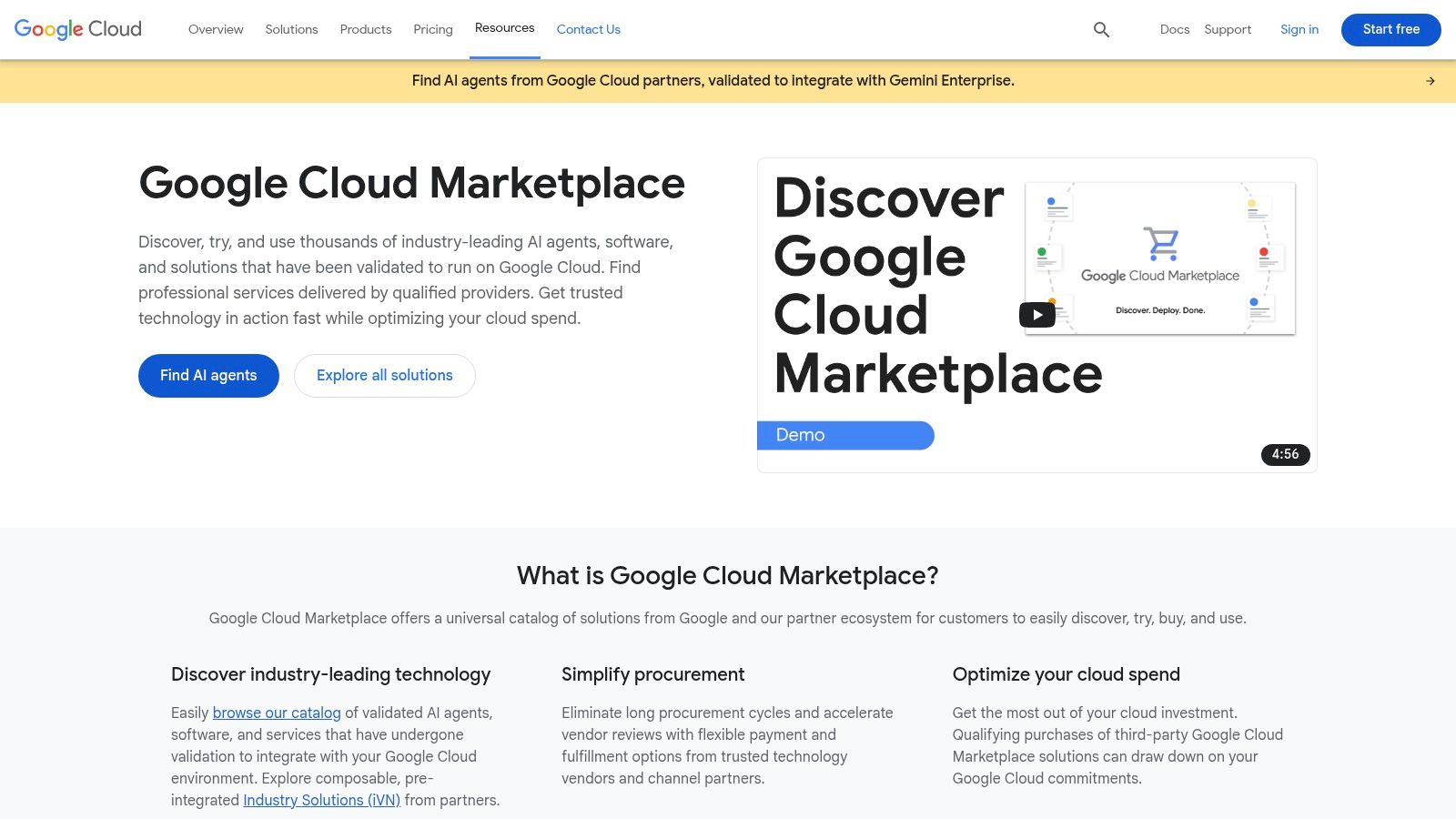
The platform’s strength lies in its deep integration with Google's powerful AI and data tools, particularly Vertex AI. For teams already using Google's infrastructure, the marketplace acts as a force multiplier, offering ready-to-deploy models and foundational datasets. This curated environment, which includes a dedicated Generative AI area, simplifies the process of finding specialized AI solutions for complex medical challenges. It streamlines the entire journey from discovery to deployment on platforms like Google Kubernetes Engine (GKE), making it a go-to resource for any AI healthcare company operating within the Google ecosystem.
Core Offerings and Use Cases
The marketplace provides filtered views to help organizations pinpoint the exact tools needed for their specific healthcare initiatives.
Generative AI and Foundational Models: Access and fine-tune large language models (LLMs) like Med-PaLM 2 for clinical documentation summaries, patient communication drafts, and medical research synthesis. This allows for the rapid development of sophisticated AI-powered applications.
De-identification and Data Privacy: Deploy pre-built APIs and solutions to automatically de-identify protected health information (PHI) from unstructured text and medical images, ensuring HIPAA compliance while unlocking data for research and analysis.
Life Sciences Research: Procure specialized datasets and bioinformatics tools to accelerate drug discovery, genomic analysis, and clinical trial data management. Solutions from vendors on the marketplace can significantly shorten research and development timelines.
Key Insight: A major advantage is the ability for enterprises to use existing Google Cloud spending commitments to purchase third-party software from the marketplace. This financial flexibility allows companies to reallocate infrastructure budgets toward innovative AI applications without new spending approvals.
Implementation and Pricing
The marketplace is engineered for ease of use for teams familiar with Google Cloud. Solutions can be deployed with minimal friction, often directly into a GKE or Vertex AI environment. Governance is a key feature, with options to create a private marketplace that restricts employees to a pre-approved list of vendors and solutions, ensuring compliance and security.
Pricing models are vendor-specific and offer diverse options:
Usage-Based: Pay for what you use, ideal for pilot projects and experimentation.
Subscriptions: Fixed monthly or annual fees for predictable cost management.
Bring Your Own License (BYOL): Use an existing license from a vendor on Google Cloud's infrastructure.
While many listings offer a streamlined purchase process, be aware that some may route to a partner's sales team for final contracting. A clear understanding of your AI Product Development Workflow is vital for integrating these tools and managing both the software and underlying infrastructure costs effectively.
Website: https://cloud.google.com/marketplace
4. Epic Showroom / Epic Connection Hub (EHR app directory)
For the vast number of U.S. health systems built on Epic's Electronic Health Record (EHR) platform, the Epic Showroom and Connection Hub are indispensable resources for innovation. Rather than a marketplace for direct purchases, this platform acts as a curated and verified directory of third-party vendors whose solutions interoperate with Epic. It serves as a critical first stop for hospital IT and clinical leadership to discover vetted partners that can securely connect to and enhance their core EHR workflows.
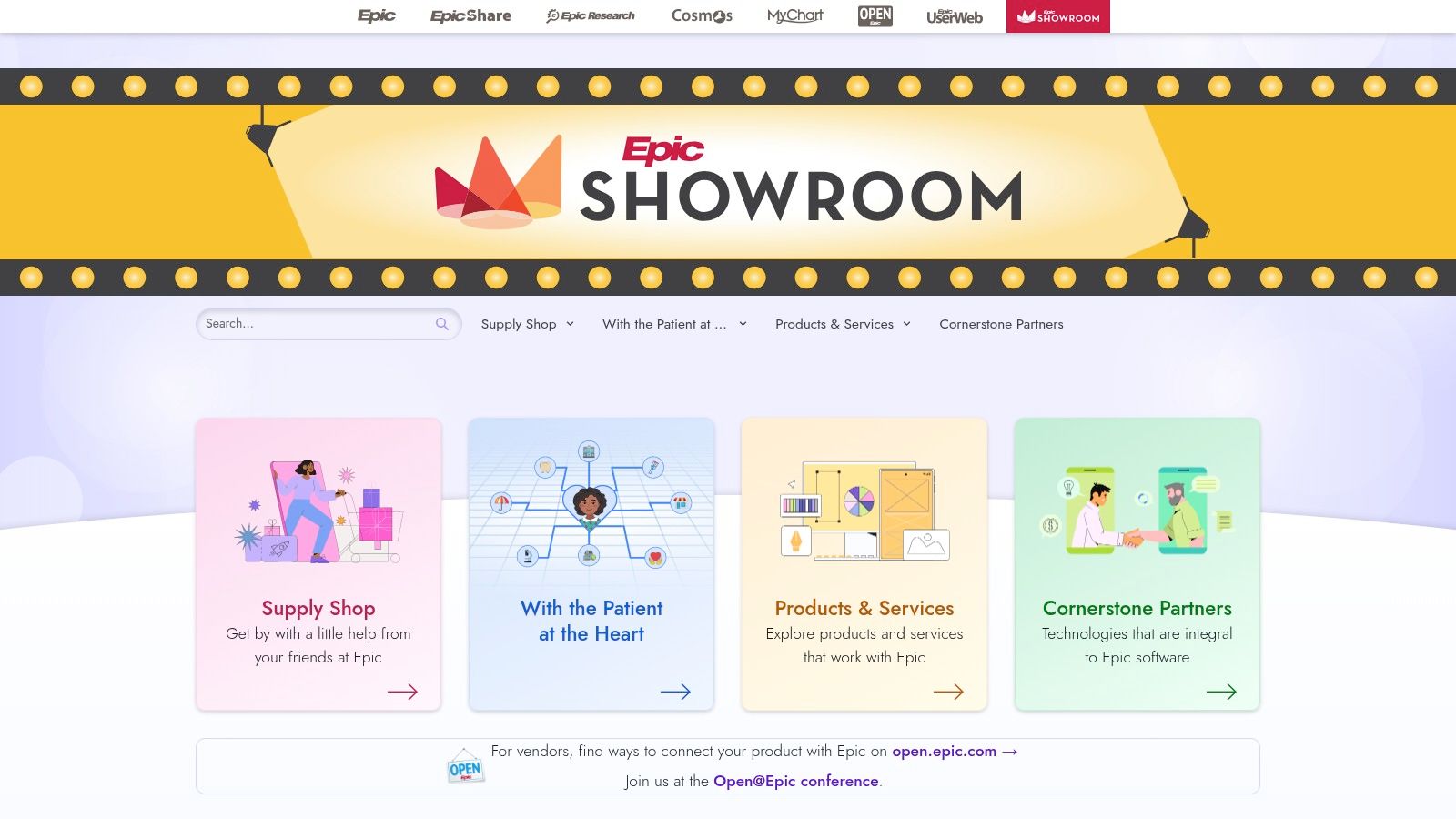
This directory's primary value lies in de-risking technology adoption. By featuring solutions with established integration points, it significantly shortens the vendor evaluation cycle. Health systems can confidently find AI healthcare companies that won't require starting from scratch to connect to patient data, scheduling, or billing systems. The directory distinguishes between the "Connection Hub," where vendors can self-report their interoperability capabilities, and the "Showroom," which highlights solutions that have undergone a deeper, more collaborative integration process with Epic. This distinction helps organizations gauge the maturity of a potential integration.
Core Offerings and Use Cases
The directory is structured around key clinical and operational domains, making it easy to find solutions for specific challenges within the Epic ecosystem.
Ambient Clinical Documentation: Discover AI-powered scribes that listen to patient-clinician conversations and automatically generate clinical notes directly within the Epic interface, reducing physician burnout.
Imaging AI & Diagnostics: Find AI algorithms that integrate with Epic's imaging viewer, Radiant, to assist radiologists in identifying potential findings in scans and automatically populating reports with structured data.
Clinical Decision Support: Source tools that analyze patient data in real-time to provide alerts and recommendations at the point of care, such as predicting sepsis risk or identifying patients eligible for specific clinical trials.
Patient Engagement: Identify applications that connect with MyChart, Epic's patient portal, to deliver personalized health coaching, appointment reminders, and remote monitoring powered by AI.
Key Insight: The Epic Showroom isn't just a list; it's a strategic roadmap. The categories and vendors Epic chooses to highlight signal the technological areas the EHR giant is prioritizing, giving health systems a clear view of future-proof integration opportunities.
Implementation and Pricing
The platform itself is a free-to-browse directory. The actual implementation and contracting process happens directly between the health system and the third-party vendor. Once a vendor is selected, the integration process leverages Epic's standardized APIs and integration tools, but the complexity and cost can vary significantly based on the solution's depth.
Procurement follows a traditional vendor-direct model:
Discovery: Use the Showroom/Hub to create a shortlist of vendors with proven Epic interoperability.
Contracting: Negotiate licensing, pricing, and service level agreements directly with the chosen AI company.
Integration: Work with the vendor and internal IT teams to connect the solution to your specific Epic instance.
For healthcare organizations, aligning these external tools with internal processes is paramount. Understanding the nuances of deploying new solutions within this ecosystem is a core part of effective AI in healthcare.
Website: https://showroom.epic.com
5. Siemens Healthineers Digital Marketplace (teamplay Digital Health Platform)
For healthcare providers deeply invested in the Siemens ecosystem, the Digital Marketplace on the teamplay Digital Health Platform is a streamlined gateway to cutting-edge AI. Rather than being a standalone vendor, it functions as a highly integrated and curated app store for clinical AI, primarily focused on medical imaging. It allows organizations to discover, trial, and deploy AI solutions from both Siemens and a vetted list of third-party developers directly into their existing workflows, such as the syngo.via imaging software.
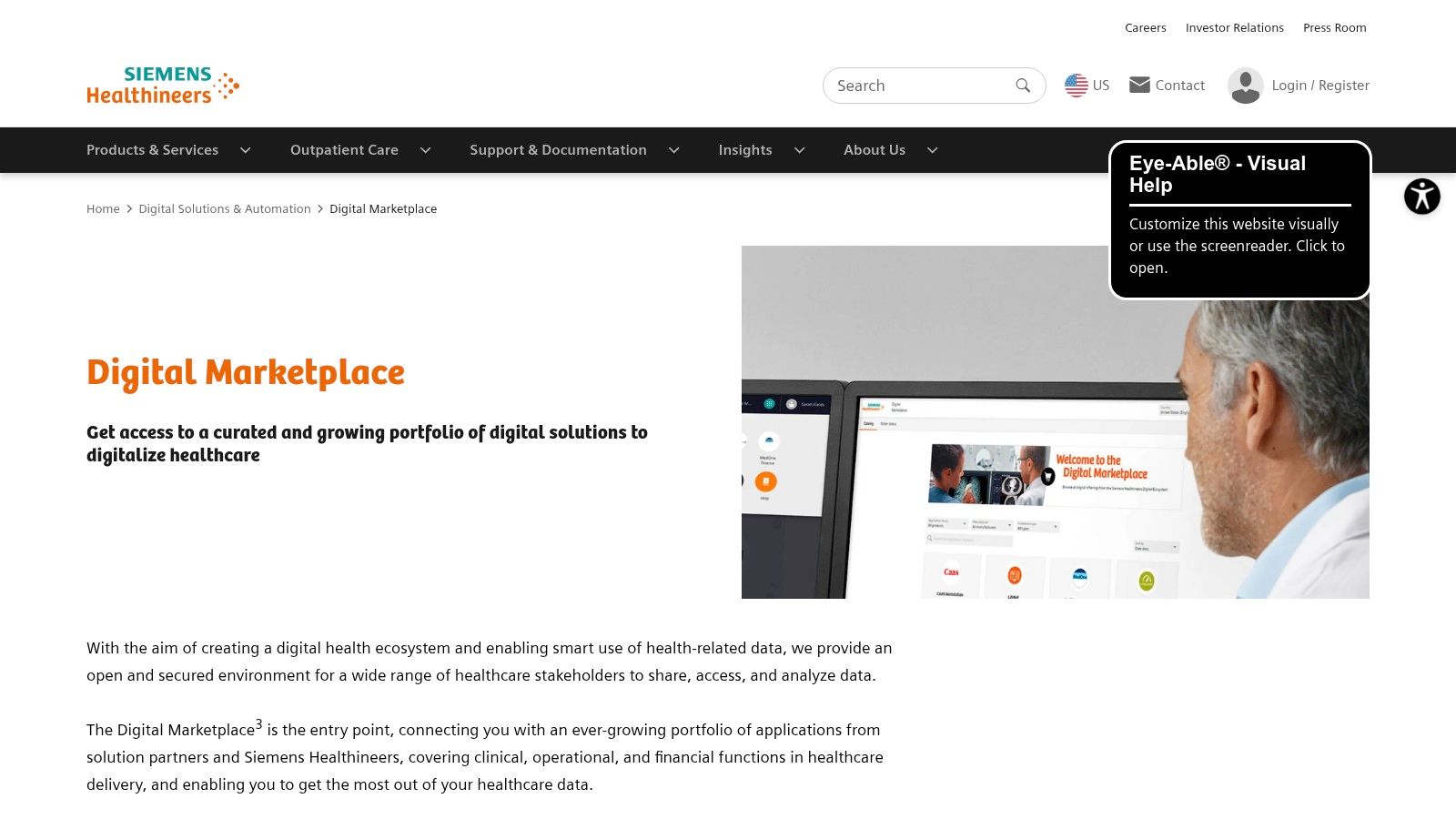
This platform's primary advantage is its deep integration, which significantly lowers the technical and operational barriers to adopting new technologies. For an organization already using Siemens hardware and software, adding a new AI capability becomes a much simpler process of procurement and activation rather than a complex IT project. The marketplace centralizes security vetting, support, and sales engagement, making it a powerful tool for any AI healthcare company seeking to enhance diagnostic capabilities within an established operational framework.
Core Offerings and Use Cases
The Digital Marketplace is purpose-built to augment clinical decision-making, with a strong emphasis on radiology and diagnostic imaging workflows.
Diagnostic AI for Imaging: Deploy specialized algorithms that assist in the analysis of CT scans, MRIs, and X-rays. Applications from partners like Circle CVI or Cortechs Labs can automatically perform tasks like cardiac function analysis or brain tissue segmentation, providing quantitative data to support a radiologist's interpretation.
Workflow Efficiency Tools: Find applications designed to automate repetitive tasks and optimize department operations. This includes tools for automatic triage of critical findings in imaging studies, ensuring that urgent cases are prioritized for review.
Integrated Digital Companions: Access Siemens' own AI-powered "Companions" that are embedded within specific imaging modalities. These tools provide real-time support for protocol selection, image quality control, and post-processing, standardizing care and improving consistency.
Key Insight: The true value of the Siemens Healthineers Digital Marketplace lies in its "plug-and-play" nature for existing customers. By pre-vetting apps for technical compatibility and security, it removes the riskiest and most time-consuming steps of AI adoption for imaging departments.
Implementation and Pricing
Deployment is designed to be seamless for organizations on the teamplay platform or using syngo.via. Once an application is selected and purchased, it can be enabled within the existing software environment, minimizing disruption. This tight integration is a major benefit but also means the platform delivers the most value to organizations already committed to the Siemens ecosystem. App availability is also subject to regional and country-specific regulatory clearances.
The platform supports a range of commercial models to fit different budgetary needs:
Subscription-Based: Annual or multi-year licenses for predictable, ongoing access.
Pay-per-Use: A consumption-based model where costs are tied directly to the number of cases or studies analyzed.
One-Time Purchase: Perpetual licenses for specific applications or versions.
Prospective users can browse solutions, request demos or quotes, and manage trials directly through the marketplace portal. A clear understanding of your diagnostic volumes and how a new tool fits into your AI Product Development Workflow is key to selecting the most cost-effective pricing model.
Website: https://www.siemens-healthineers.com/en-us/digital-health-solutions/digital-marketplace
6. Snowflake Marketplace (AI Data Cloud for Healthcare & Life Sciences)
For healthcare and life sciences organizations built on the Snowflake Data Cloud, the Snowflake Marketplace offers a fundamentally different approach to adopting AI. Instead of moving sensitive data to external applications, this platform allows organizations to discover, try, and deploy third-party datasets and pre-built AI applications directly within their own secure Snowflake environment. This "in-place" model is a game-changer for handling Protected Health Information (PHI) and Personally Identifiable Information (PII), drastically reducing data governance risks and integration complexities.
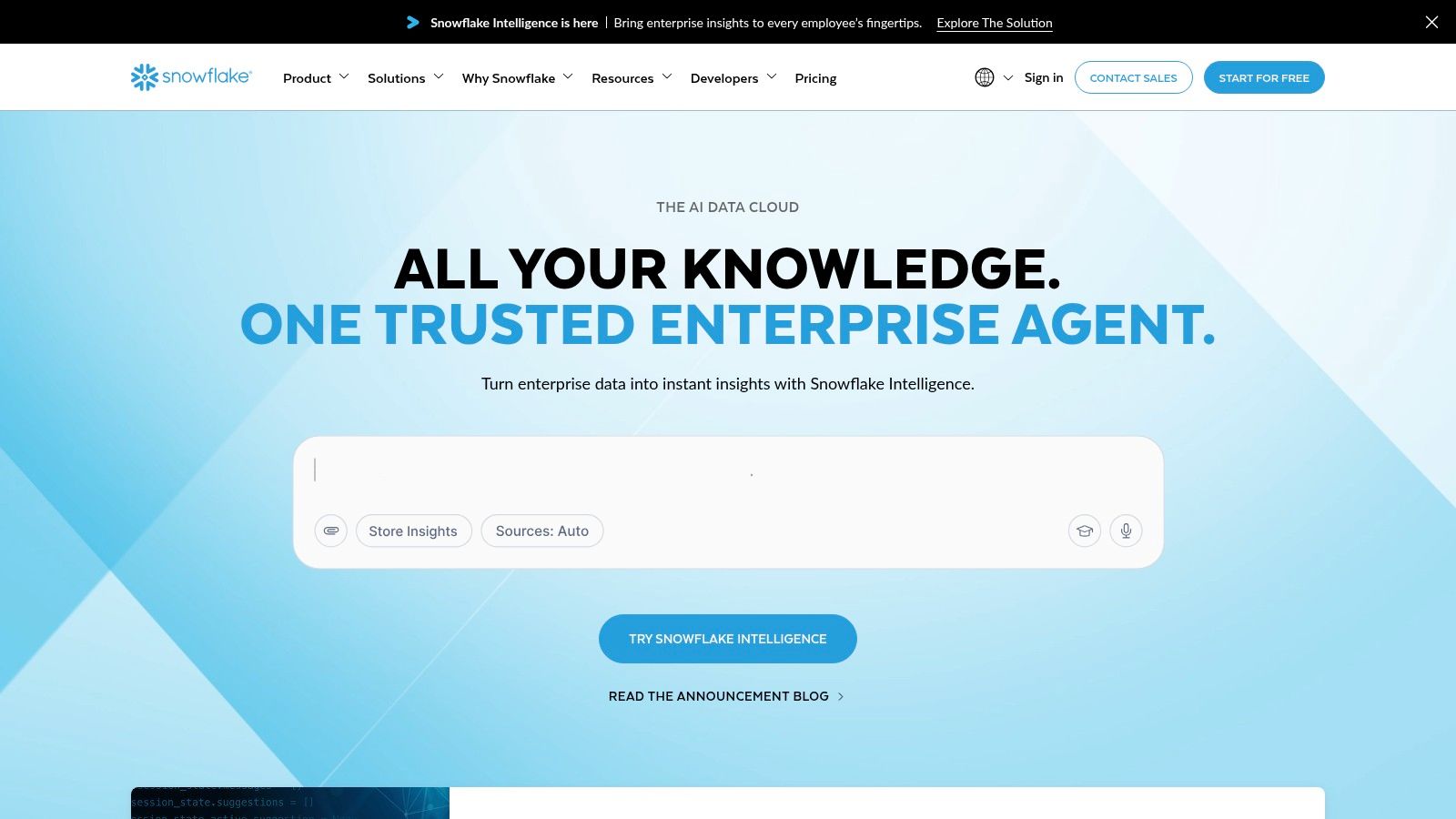
The platform’s core advantage lies in its Snowflake Native App framework, which enables vendors to ship powerful AI models and applications that run entirely inside the customer’s account. This eliminates the need for data pipelines to third-party services, ensuring that sensitive data never leaves the organization's security perimeter. By centralizing access to specialized AI solutions and datasets, the marketplace accelerates the journey from data to insight for providers, payers, and life sciences firms looking to become leading AI healthcare companies.
Core Offerings and Use Cases
The Snowflake Marketplace provides a curated selection of transactable native apps and data listings specifically designed for the healthcare ecosystem.
Clinical and RCM AI Agents: Deploy Snowflake Native Apps like those from Hippocratic AI or Observe.AI. These applications can function as coding and billing agents, analyzing unstructured clinical notes or patient interactions to suggest accurate medical codes, thereby optimizing revenue cycle management.
Imaging and Omics Analytics: Access specialized apps that process and analyze large-scale medical imaging or genomics data directly within Snowflake. This enables researchers and clinicians to run complex analytical queries without moving petabytes of data.
Enriched Data Sets: Augment internal datasets by accessing third-party data for social determinants of health (SDOH), medical claims, or life sciences research. This allows for more comprehensive population health analysis and clinical trial design.
Key Insight: The "bring the app to the data" model of Snowflake Native Apps is a paradigm shift. It means organizations can trial and deploy sophisticated AI without lengthy data sharing agreements or complex API integrations, significantly lowering the barrier to entry for advanced analytics.
Implementation and Pricing
The implementation process is streamlined for existing Snowflake users. Authorized users can discover an app on the marketplace and install it directly into their account with a few clicks. All governance, access controls, and auditing are managed through Snowflake's native role-based access control (RBAC), ensuring consistency with existing security policies. The primary prerequisite is an active Snowflake account and the necessary permissions to install applications.
Pricing is integrated directly into the Snowflake ecosystem:
Usage-Based: Many apps are priced on a pay-as-you-go model, tying costs directly to consumption.
Contracts & Private Offers: Negotiate custom terms and subscription pricing directly with providers for predictable budgeting.
Costs are consolidated into a single Snowflake bill, which includes both the application fee and the underlying Snowflake compute credits used to run it. Organizations must factor both components into their cost analysis, where a well-defined AI Product Development Workflow can help manage and predict expenses effectively.
Website: https://www.snowflake.com
7. ACR Data Science Institute – AI Central (FDA-cleared Imaging AI directory)
For healthcare providers navigating the complex landscape of medical imaging AI, the American College of Radiology’s (ACR) AI Central is an indispensable, vendor-neutral resource. It functions as a comprehensive and consistently updated directory of FDA-cleared imaging AI products available in the U.S. Instead of relying on vendor marketing, clinical leaders can use this platform to conduct objective due diligence, shortlisting potential solutions based on critical, verified data.

This platform stands out by demystifying the procurement process for one of the most impactful segments of healthcare AI. By centralizing objective metadata pulled directly from FDA clearance documents, it empowers hospitals and imaging centers to make informed decisions. This resource helps organizations align technology choices with their specific patient populations, existing technical infrastructure, and clinical needs, a core step in developing effective AI tools for business. It provides a crucial first step before engaging with manufacturers for demos, pricing, and final procurement.
Core Offerings and Use Cases
AI Central is designed for targeted discovery, allowing users to filter and find highly specific imaging algorithms.
Search and Filter by Clinical Need: Users can search the directory of over 200 FDA-cleared products by modality (e.g., CT, MRI, X-ray), body region (e.g., chest, neuro), and specific clinical indication (e.g., stroke detection, lung nodule analysis). This granular search capability is vital for matching a tool to a precise care pathway.
Objective Due Diligence: The platform provides direct access to objective data, including product clearance type (510(k), De Novo) and links to the manufacturer’s instructions for use. This allows for an unbiased comparison of different AI healthcare companies and their offerings.
Transparency Verification: AI Central features ‘Transparent-AI’ badges for vendors who voluntarily disclose key details about their product’s training and validation datasets. This initiative encourages transparency and helps providers assess an algorithm's potential for bias and its applicability to their own patient demographics.
Key Insight: AI Central is not a marketplace but a crucial pre-procurement tool. It enables clinical and IT leaders to build a data-driven business case for an AI solution before entering sales discussions, strengthening their negotiating position and ensuring the selected tool meets genuine clinical needs.
Implementation and Pricing
As a directory, AI Central does not handle deployment or sales. The primary user experience is centered on its powerful search and comparison interface, which is free to access. Once a promising product is identified, the platform provides links to the manufacturer's website, where the procurement process begins.
The actual implementation and pricing are managed directly with the AI vendor and will vary significantly.
Procurement: Handled directly with the manufacturer after using AI Central for initial research and shortlisting.
Pricing Models: Vendor-specific, often involving licenses, per-scan fees, or subscription models.
Implementation: Requires integration with the organization’s existing PACS (Picture Archiving and Communication System) and radiology workflow, a process managed by the vendor and the healthcare organization’s IT department.
Organizations looking to implement these specialized tools can explore how they fit into a broader strategy by evaluating tools like a diagnostic AI platform to manage various algorithms.
Website: https://aicentral.acrdsi.org
7-Platform AI Healthcare Marketplace Comparison
| Solution | Implementation complexity | Resource requirements | Expected outcomes | Ideal use cases | Key advantages |
|---|---|---|---|---|---|
| AWS Marketplace – Healthcare & Life Sciences | Moderate — requires AWS account and IAM familiarity | AWS environment, cloud infra costs, engineering for integration | Faster procurement and AWS-native deployment of healthcare AI | Organizations already on AWS needing imaging, NLP, or analytics | Fast procurement, native AWS integration, transparent pricing options |
| Microsoft Azure Marketplace (Microsoft commercial Marketplace) | Moderate — best when workloads already on Azure; some listings are services | Azure tenant, governance controls, possible partner consulting resources | Consolidated billing and vetted deployments leveraging Azure services | Azure-standardized providers/payers seeking FHIR, OpenAI, or deployed apps | Enterprise billing, security/compliance vetting, tenant-level governance |
| Google Cloud Marketplace – Healthcare & Life Sciences | Moderate — optimized for Vertex AI/GKE deployments | Google Cloud account, Vertex AI/GKE resources, admin roles | Curated trials and deployments with consolidated billing and governance | Teams building on Vertex AI or standardized on Google Cloud | Strong procurement workflows, drawdown of Google commitments |
| Epic Showroom / Epic Connection Hub (EHR app directory) | Low–Medium — directory discovery; integration complexity varies by vendor | Vendor contracts, EHR integration work, clinical and IT validation | Shortlisted Epic-verified integrations and reduced integration risk | Health systems using Epic evaluating interoperable clinical apps | Epic-validated listings, clearer integration status, shorter vendor shortlists |
| Siemens Healthineers Digital Marketplace (teamplay) | Low–Medium — smoother if using Siemens platforms | teamplay/syngo.via platforms, imaging systems, vendor engagement | Streamlined deployment of imaging AI with Siemens workflow integration | Siemens imaging customers seeking imaging AI or modality integrations | Lower integration overhead for Siemens users, centralized support/ticketing |
| Snowflake Marketplace (AI Data Cloud) | Moderate — requires Snowflake account and appropriate roles | Snowflake environment, governance/audit controls, data engineering | In-account apps/datasets keeping PHI in place; reduced data movement | Organizations storing PHI in Snowflake wanting data-native AI apps | Keeps data in-place, centralized governance, Snowflake billing |
| ACR Data Science Institute – AI Central (FDA-cleared directory) | Low — directory research only; purchasing is external | Clinical evaluation teams, vendor procurement and validation efforts | Thorough due diligence and shortlist of FDA-cleared imaging AI products | Radiology leaders comparing cleared imaging AI by modality and indication | Vendor-neutral FDA metadata, ‘Transparent-AI’ badges, clinical filters |
Final Thoughts
Navigating the complex landscape of AI healthcare companies can feel overwhelming, but the platforms we've explored provide a structured gateway to transformative technologies. From the comprehensive cloud offerings of AWS, Microsoft, and Google Cloud to specialized, domain-specific marketplaces like Epic's Showroom for EHR integration and the ACR's AI Central for FDA-cleared imaging algorithms, the options are as diverse as the challenges in modern healthcare. The key takeaway is that you don't have to build everything from scratch. These ecosystems offer a powerful starting point, enabling healthcare organizations to leverage pre-vetted, state-of-the-art tools to accelerate innovation and improve patient outcomes.
The journey from identifying a potential AI solution to successful implementation is strategic. It requires a clear understanding of your organization's unique needs, existing infrastructure, and long-term goals. The platforms detailed in this guide serve as a curated catalog, but the selection process itself is a critical exercise in due diligence and strategic alignment.
Key Takeaways and Actionable Next Steps
To move forward effectively, it's crucial to distill this information into a concrete action plan. Reflect on these points as you consider which of these AI healthcare companies and platforms best align with your objectives.
Define Your Core Problem: Before browsing any marketplace, clearly articulate the specific problem you aim to solve. Is it improving diagnostic accuracy with AI-powered imaging tools? Streamlining administrative workflows to reduce clinician burnout? Or leveraging data analytics for population health management? A well-defined problem is the foundation of a successful AI implementation.
Assess Your Ecosystem Compatibility: Consider your current technology stack. If your organization is heavily invested in Microsoft Azure, its marketplace is a natural starting point. Similarly, if your entire operation revolves around the Epic EHR, the Epic Showroom is non-negotiable for seamless integration. Compatibility minimizes friction and accelerates deployment.
Prioritize a Phased Implementation: Avoid the temptation to overhaul everything at once. Start with a pilot project that addresses a high-impact, well-defined use case. This approach, as we explored in our AI adoption guide, allows you to demonstrate value, secure buy-in from stakeholders, and learn valuable lessons before a full-scale rollout. A successful pilot builds momentum for broader digital transformation.
Selecting the Right Partner and Preparing for Implementation
Choosing a tool is only half the battle; choosing the right partner and preparing your organization for change is equally important. When evaluating solutions from various AI healthcare companies, consider the following factors:
Regulatory and Compliance Alignment: Ensure any tool you consider is compliant with HIPAA, GDPR, and other relevant regulations. For clinical applications, verify its FDA clearance status, a process simplified by resources like the ACR AI Central.
Data Strategy and Governance: AI is fueled by data. Before implementing any new tool, conduct a thorough AI requirements analysis to ensure you have the necessary data infrastructure, quality, and governance policies in place. Platforms like Snowflake Marketplace are specifically designed to address these data-centric challenges.
Integration and Workflow: How will this new tool fit into your existing clinical or operational workflows? A powerful algorithm that disrupts clinicians' established processes is unlikely to be adopted. Look for solutions that offer deep integration capabilities, like those found in EHR-centric marketplaces. This is a core component of our AI Product Development Workflow.
Support and Partnership: Evaluate the vendor's support model and their willingness to partner with you. A strong partner will provide robust documentation, training, and ongoing technical support to ensure you maximize the value of your investment.
The future of healthcare is undeniably intertwined with artificial intelligence. The platforms and companies we've discussed are not just technology vendors; they are critical enablers of a more efficient, intelligent, and patient-centric healthcare system. By taking a strategic, problem-focused approach, your organization can effectively harness these powerful AI tools for business and begin a new chapter of innovation and growth. For a deeper dive into practical applications, explore the real-world use cases our expert team has analyzed.
Navigating the world of AI healthcare requires more than just tools; it demands a clear strategy and expert guidance. At Ekipa AI, we specialize in helping organizations develop and implement a cohesive AI strategy consulting plan, from identifying high-value use cases to building internal tooling and ensuring seamless integration. Let our expert team help you translate technological potential into tangible business outcomes.
Frequently Asked Questions (FAQ)
What are the biggest challenges AI healthcare companies face?
AI healthcare companies face several significant challenges, including strict regulatory hurdles like FDA clearance and HIPAA compliance, the need for high-quality, diverse, and unbiased training data, and the difficulty of integrating their solutions into complex existing clinical workflows and EHR systems. Gaining trust and adoption from clinicians is another major barrier.
How do cloud marketplaces like AWS, Azure, and Google Cloud benefit AI in healthcare?
Cloud marketplaces accelerate AI adoption in healthcare by providing a vetted, centralized platform where organizations can discover, purchase, and deploy pre-built AI solutions. They reduce procurement friction, offer scalable infrastructure, ensure security and compliance, and allow organizations to leverage their existing cloud spending commitments, making it easier to experiment with and implement cutting-edge technology.
What is the difference between a marketplace and a directory like Epic Showroom?
A marketplace (e.g., AWS Marketplace) is a transactional platform where you can directly purchase and deploy software, often with integrated billing. A directory (e.g., Epic Showroom, ACR AI Central) is a curated listing of verified partners or products. You use a directory for discovery and due diligence, but the procurement and implementation process happens directly with the vendor, outside of the directory platform.
Why is EHR integration so critical for AI healthcare solutions?
EHR integration is critical because the Electronic Health Record is the central hub of patient data and clinical workflow. For an AI tool to be effective, it must seamlessly access patient data (e.g., lab results, clinical notes) and present its insights directly within the clinician's existing workflow. Without tight integration, AI tools become standalone applications that disrupt care, leading to poor adoption and limited impact.
How can a healthcare organization start its AI adoption journey?
A healthcare organization should start by identifying a specific, high-impact problem that AI can solve, such as reducing diagnostic errors in radiology or automating administrative tasks. The next step is to conduct a thorough AI requirements analysis, assess data readiness, and explore platforms like the ones listed in this article to find compatible solutions. Starting with a focused pilot project is a proven strategy to demonstrate value and build momentum for broader adoption.



